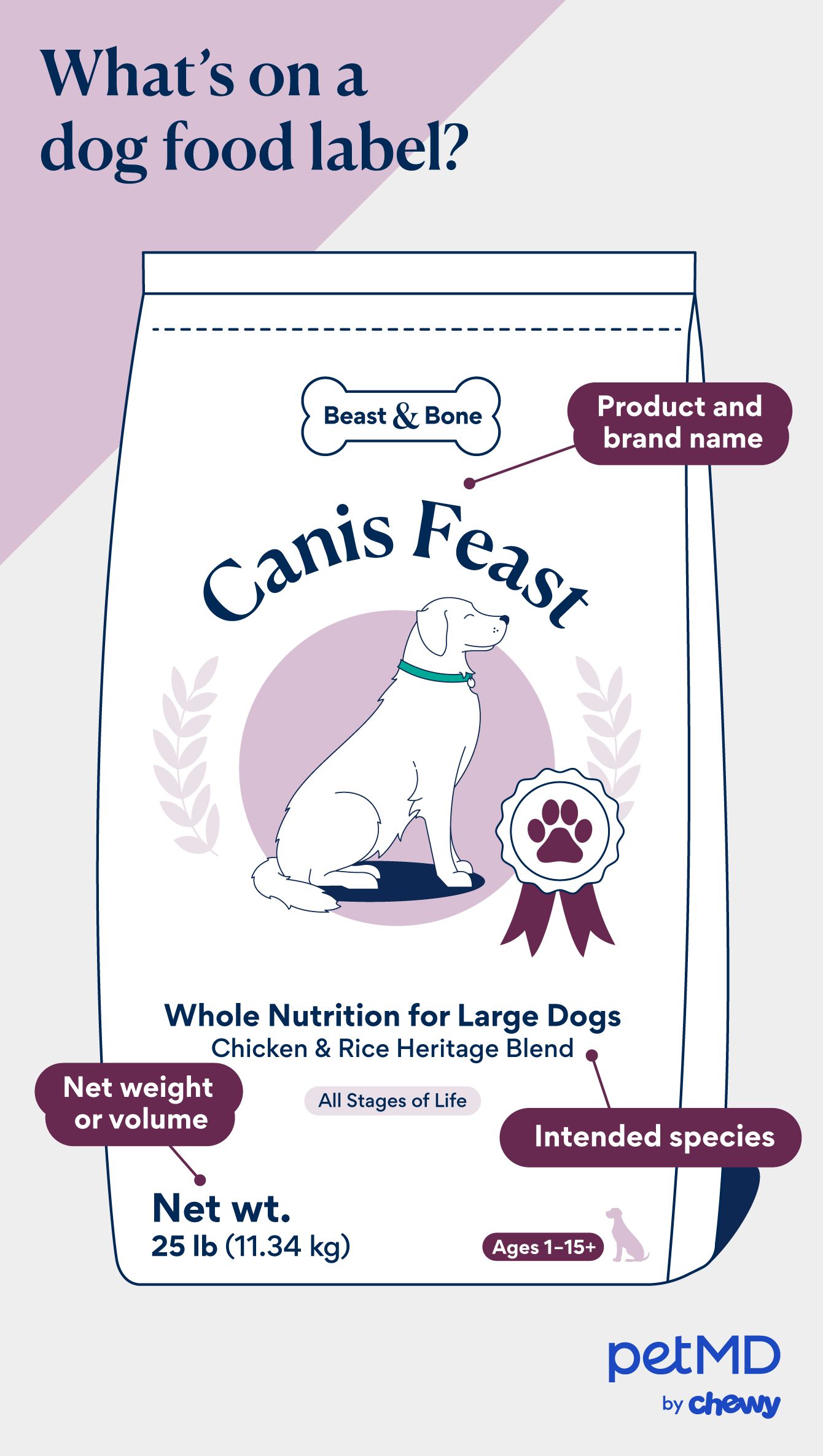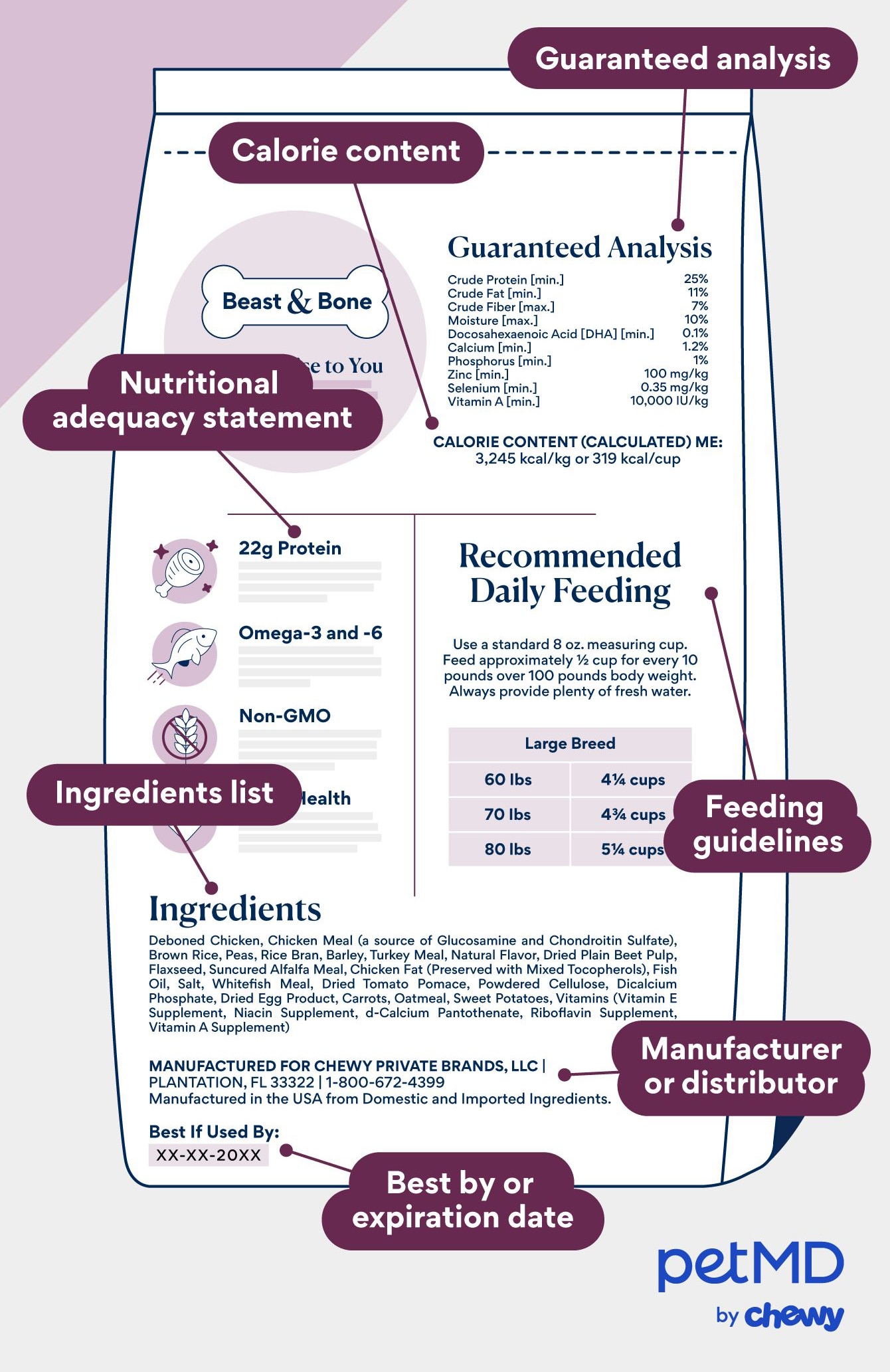A Guide to Dog Food Ingredients and Reading Dog Food Labels
While your pet’s veterinarian can help determine the best food for your four-legged friend, it also helps to better understand what you’re feeding your dog, what nutrients your dog needs, and how to read dog food label.
The ingredients in dog food can make a big difference in supporting your pup’s health.
Understanding Dog Food Ingredients
Certain ingredients in dog food provide your dog with many different, essential nutrients.
The major nutrients that your dog needs to survive are proteins, carbohydrates, fats, and water. These ingredients make up the bulk of the nutrient requirements for dogs.
Protein, carbohydrate, and fat sources are listed on dog food labels first, followed by vitamins and minerals, probiotics, preservatives, and other ingredients.
Proteins
A high-quality, lean source of protein supplies essential amino acids and can help your dog build and maintain lean muscle mass, form new skin cells, and grow hair.
Proteins include:
-
Meat, such as beef and lamb
-
Fish, such as salmon and whitefish
-
Plant-based sources like soy
They may be in the form of whole muscle tissue, meals, or by-products.
Carbohydrates
Simple and complex carbohydrates are not only an energy source, but they also provide fiber for gut health.
Sources include:
Fiber helps keep a dog's colon healthy and helps maintain normal gastrointestinal function. Sources include:
-
Wheat bran
-
Inulin (a type of prebiotic)
-
Powdered cellulose (a good source of insoluble fiber)
-
Beet pulp (a complex carbohydrate)
-
Dried chicory root
-
Fructooligosaccharides (plant sugars)
Fats
A healthy fat source, such as that with omega-3 fatty acids and omega-6 fatty acids, provides energy and can help support joint and skin health, reduce inflammation in the body, and support cell and nerve function.
Animal or plant-based fats or oils include:
-
Beef or chicken fat
-
Corn, soybean, or canola oil
Water
Water can be found in small amounts in dry dog food and in larger amounts in wet dog food.
Your dog will also usually drink enough water outside of meals to fulfill their daily requirement.
Vitamins and Minerals
Dogs also need vitamins and minerals in their diet, such as:
-
Vitamin A
-
Vitamin D
-
Vitamin E
-
Vitamin K
-
B vitamin complex
-
Calcium
-
Phosphorus
-
Magnesium
-
Potassium
-
Sodium and chloride (salt)
-
Iron
-
Copper
-
Zinc
-
Manganese
-
Selenium
-
Iodine
These various vitamins and minerals help support organ function and the health of your pet’s eyes, skin, immune system, bones, heart, nervous system, digestive system, and thyroid.
As for sodium and chloride, they help balance your dog’s body fluids and your dog’s pH levels, respectively.
Preservatives, Probiotics, and More
Other ingredients found in dog food include:
-
Probiotics: Probiotics include Lactobacillus acidophilus and Enterococcus faecium.
-
Preservatives: Artificial preservatives (BHA, BHT, and ethoxyquin) and natural preservatives (calcium propionate, ascorbic acid/vitamin C, and mixed tocopherols) extend shelf life and keep the food fresh.
-
Other ingredients: Carrageenan from seaweed, for example, improves texture and enhances the food’s appeal.
Ingredients To Avoid in Dog Food
As for dog food ingredients to avoid, they include:
-
Toxic ingredients: Some dog foods can contain ingredients that may be toxic to your dog when consumed long-term, such as garlic powder, oregano, and lavender. While less common, other harmful ingredients to avoid include chocolate, avocado, citrus, dairy, and nuts.
-
Raw ingredients: Raw ingredients pose a risk of Salmonella and E. coli bacterial infections, not only for your dog but also for you when handling raw products. Always feed your dog a fully cooked diet.
-
Ingredients your dog is sensitive to: If your dog has an allergy or sensitivity to a particular ingredient, avoid it. Your veterinarian can help determine the best diet for your dog if they have a food sensitivity or allergy.
Animal By-Products and Fillers
Other commonly criticized ingredients are animal by-products and “fillers.”
However, animal by-products are simply meat trimmings and organ meats that provide protein and essential nutrients like vitamins and minerals for your dog.
As for fillers, these are often fiber sources that help your dog’s digestive system stay healthy and regular.
Both can be important components of dog food.
How To Read a Dog Food Label
At first, the amount of information on a bag or can of dog food can seem overwhelming.
However, with a bit of practice, you can learn how to read a dog food nutrition label with ease and know which foods are most appropriate for your dog.
Here are the key parts of a dog food label that are important to understand:


Guaranteed Analysis
This lists the amounts of key nutrients found in the food.
The most common nutrients included here are percentages of crude protein, crude fat, crude fiber, moisture, calcium, and phosphorus, as well as the milligram amounts of selenium, vitamin A, vitamin E, ascorbic acid (vitamin C), and omega-3 fatty acids.
Ingredients List
The ingredients of the diet are listed in descending order by weight.
The first ingredient is always the protein source, followed by carbohydrates, fats, fiber, and then vitamins and minerals.
Calorie Content
Calories are typically listed in kilocalories per kilogram and per cup, can, or biscuit.
Knowing the calories per cup helps you adjust the daily feeding amount to meet your dog’s specific needs.
Feeding Guidelines
These provide a general idea of how many cups per day to feed your dog, which can vary based on age, health status, spay/neuter status, and weight goals.
Nutritional Adequacy Statement
Also called an AAFCO (Association of American Feed Control Officials) statement, this indicates whether the diet is complete and balanced according to AAFCO standards for a particular life stage, from puppy growth to adult and senior maintenance.
Best By or Expiration Date
This freshness date ensures the food maintains its nutritional quality.
How To Choose the Right Dog Food
One factor that can help narrow down the list of potential foods for your dog is the brand.
Major dog food brands like Purina®, Hill’s®, Iams™, Royal Canin®, and Eukanuba™ consistently produce high-quality diets that meet AAFCO standards for complete and balanced nutrition at every life stage.
From there, you can select from a variety of options based on your dog’s age, size, and even breed.
Each of these brands offers puppy, adult, and senior foods, as well as formulas tailored to small- or large-breed dogs.
Royal Canin even has “breed health” diets for specific purebred dogs such as German Shepherds, Chihuahuas, and Bulldogs.
Your veterinarian can help determine when your dog is ready to transition from puppy food to adult food, and from adult food to senior food.
Many of these brands also offer specialty over-the-counter diets for weight management and for sensitive stomach and skin.
Dog Food Ingredients FAQs
What should the first five ingredients in dog food be?
Ideally, the first five ingredients in dog food should be (in order):
-
Protein source
-
Carbohydrates
-
Fats
-
Vitamins
-
Minerals
How do I store my dog food properly?
For dry dog food, it’s best to store opened bags in airtight, hard-sided containers in a dry, cool location. This helps preserve the kibble’s freshness and prevent pests from accessing the food.
For canned dog food, the can should be tightly sealed between uses, refrigerated at 37 F or lower after opening, and discarded after three to four days to ensure the food stays fresh.
What’s the difference between whole food ingredients and processed ingredients?
Whole ingredients are added to the diet largely unchanged outside of the cooking or baking process.
Processed ingredients include various types of “meals”—hydrolyzed proteins, pulps, and digests—that have been broken down into smaller pieces and often mixed with preservatives.
These are used to concentrate the nutrient content or to make the product more digestible or shelf-stable, maintaining freshness for a longer time.
